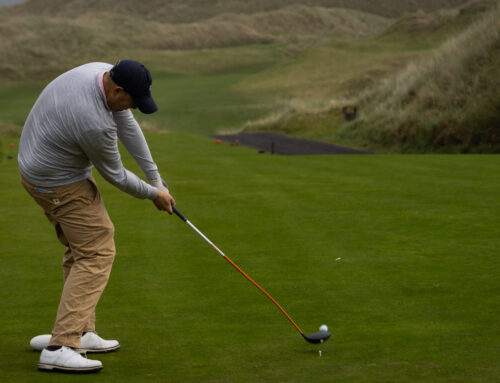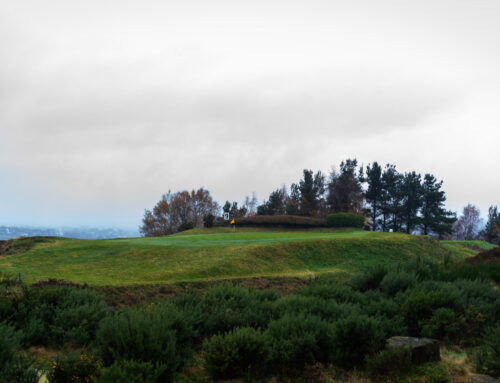Words by Sam
I recently saw that the average millennial is scrolling the length of the Eiffel Tower on a daily basis. As someone spending more time on social media than he would willingly share with his friends, my Eiffel Tower is probably more like a Burj Khalifa, or at best one of the Petronas buildings.
Recently, things have got worse with a dose of reels when scrolling the phone at nighttime, and with lots of other things competing for attention I realised the amount of books I have read in 2023 is down on previous years’ efforts, a shame because there is really no replacement for a book.
So with Christmas and some much needed downtime ahead of us all as we head into December, i thought i would put together a shortlist of some books that I have managed to read and enjoy this year, in the hope that they might find their way into your hands over the festive break, or at the very least serve as stocking fillers for others who you feel might enjoy them…
The Links, by Robert Hunter
Hunter’s seminal work, written in 1926 is as relevant today as it was back then. It was written to serve as a manual, targeted at budding golf course constructors in an American era when courses were springing up all over the land. A pilgrimage to the ancient links of Great Britain where he writes so fondly of, as well as drawing on exceptional case studies from the early courses in the US form the basis for many of his stories.
These look at concepts like green size, placement and frequency of hazards, even down to construction, budgets and of course… distance. Interestingly though, Robert Hunter was not an architect, player or developer, he was a keen amateur in the subject and wanted to explore, understand and eventually share his wisdom.
The above description written by yours truly could not do more to understate the quality of the book. It does not read like a dossier for future developers, and is not starchy or difficult to follow. Instead it is thoughtful and insightful, and will light a fire in you, regardless of your interest in subjects like golf course architecture, or course management.
The book is widely considered Ground Zero for writings about the subject of course design and construction, and revered by all the greats who followed him. Throughout the book, Robert Hunter beautifully summarises what makes this game so magical, perhaps no more so than:
‘It is not the love of something easy which has drawn men like a magnet for hundreds of years to this royal and ancient pastime; on the contrary, it is the maddening difficulty of it’
Copies of differing vintages can be picked up from a few pounds for a simple copy right up to a level where you might need to part with an organ for an original first edition.

How to Become a Scratch Golfer, Patrick Campbell
Let’s get one thing straight, this has nothing to do with improving your own game. This book came to me as a gift from a previous guest of the podcast, James Ellis Caird. His book – ‘the uncorrupted pleasure of an old bladed putter’ was a hit last year, and this was no doubt influential when he began to write a book. A short, simple read which looks at the character of a golfer at every end of the spectrum – from the ‘tiger’ to the ‘rabbit’ – whilst exploring their psyche and their idiosyncrasies, and does so in a compelling and very amusing way. I read this on a sun lounger in August in the space of a day and a bit, and found it extremely difficult to put down.
The best part is reserved for the closing chapter where the story of the 1949 Amateur Championship at Portmarnock – this chapter alone has subsequently featured in several other publications, notably the 1991 Walker Cup Programme – where Campbell himself made an incredible run at the title.
Patrick Campbell was also a Lord (The Third Baron of Glenavy), a journalist for the Irish times, as well as once being described by Bernard Darwin as ‘The big man with a velvet putting touch’.
Second hand hardcover copy can be secured on Amazon for £6.72, which is extraordinarily good value, although prices will almost certainly vary.

The Match, Mark Frost
On a podcast many moons ago, Bruce once described this as ‘the best exhibition of ball striking ever witnessed’. In The Match, Frost charts the story of the two leading amateurs of 1956 (Ken Venturi & Harvey Ward) playing against the two best professionals that year (Ben Hogan & Byron Nelson). It follows an exhibition match at Cypress Point Club in California, to settle a bet from some late night bravado between a pair of businessmen the night before!
The businessmen, oh just Eddie Lowery (yes Eddie Lowery who caddied for Francis Ouimet in his US Open Championship at Brookline at the tender age of 10), and George Coleman who were looking to settle a popular argument of the period about whether an Amateur golfer would ever be capable of competing against the Professionals.
The whole story revolves around what was then referred to as ‘The Crosby Clambake’ (what would become the AT&T pro-am – an event which seems to struggle to fill the field every single year and now feels like a strange few days where Bill Murray wanders out to amuse and surprise the fans with his wacky shenanigans).
Frost takes a look at this golden era of golf, where you can imagine houses in pastel tones, rooms filled with plumes of smoke, wayfarer sunglasses and martini cocktails sipped until the wee hours before the players made their way out onto the course.
It is beautifully written, well researched and links back to the central characters throughout the round. This creates a wonderful flow to the book. Having read ‘The Greatest Game Ever Played’ (also a sensational film featuring Shia LaBeouf as Francis Ouimet), and ‘The Grand Slam’ looking back at the magic of 1930 and the work of Robert Tyre Jones, The Match is without doubt the most gripping and hardest to put down of the three.
Second hand copies can be secured for as little as £2, and a fresh paperback copy from Amazon will set you back £19.73. Where my copy has gone remains a mystery….
Tales from Russet Grange, Crispin Aldrin
Imagine an episode of Men Behaving Badly, fused with Fawlty Towers set in a golf club. Now imagine that as a book. You’ve just imagined ‘Tales from Russet Grange’, a satirical and entirely fictional book by an anonymous author who I am yet to learn the name of. I secured one during the summer from their official twitter account, where the author ‘Crispin’ kindly shipped me a copy.
It’s a book which resembles so many golf clubs up and down our land filled with bizarre and eccentric characters as an anthology. This won’t talk about course architecture and you won’t learn more about sustainable agronomy, but it will amuse and delight you. You can pick it up for a quick chapter here or there, and perhaps it will make you think that golf doesn’t always have to be so serious, (well not always)!
Besides which, acquiring a copy from the author is all part of the fun! A Twitter presence for this fictional club, a testimonial on their website from the ‘authors son’s girlfriend’ declaring it as ‘sexist drivel’, and a section on the website introducing all of the characters is a brilliant touch from the person behind the madness.
A signed first edition copy can be acquired for £11.95 on their website, whether this runs to a second edition time will only tell!

The Great English Golf Boom, Michael Morrison
We had Michael onto the podcast back up in St Andrews, during the 150th Open Championship to celebrate the launch of this book. His work here is exceptionally well researched and brings to life how the game of golf sprung up in England after the watershed Open victory for Hoylake-man John Ball Jnr at Prestwick in 1890, not only the first Englishman, but also Amateur to win the coveted Claret Jug.
Before then, the game was something often snarled at by many English folk, an obscure sport played ‘north of the border’.
Whereas Stephen Proctor’s book – The Long Golden Afternoon – which was released around the same time talks about the characters, events and clubs that were instrumental in the rapid growth in popularity of the sport (which I also highly recommend), Morrison looks at things from a demographic and social lens, using data to drive a lot of the conclusions. It’s not only exceptionally well researched and put together, it’s a fascinating look at things you might not expect, like ‘why the bicycle was the vehicle that really turbocharged golfs existence’.
Michael also wrote about ‘The Worst Golf Course EVER’ in his book about Cambridge University Golf Club, a story of Coldham Common, and is a book I am reliably informed is also a very interesting read!
Copies can be secured for £25 from Waterstones, and some may still be available from the author direct on mike.morrison57@outlook.com

—
As for my festive reading list, Par Excellence by Donald Steele and Golf in the Wild by Robin Down. If i get through both of those then the month will be a success!






